
A group of boys in Thailand wanted to play soccer but where could they practice? Their village was surrounded by water, so they had no field. Inspired by the real boys of Koh Panyee, a floating playing field was built. Realistic illustrations evoke the village and its tenacious young residents.
Building a Dream: How the Boys of Koh Panyee Became Champions

Following each rhyming clues is the animal that inspired various inventions such as snowshoes and water fins. More familiar inventions are followed by lift-the-flaps to intrigue or confound more sophisticated readers.
Copy That, Copy Cat! Inventions Inspired by Animals

When 14-year-old William Kamkwamba’s Malawi village was hit by a drought, everyone’s crops began to fail. Without enough money for food, let alone school, William spent his days in the library … and figured out how to bring electricity to his village. Persevering against the odds, William built a functioning windmill out of junkyard scraps, and thus became the local hero who harnessed the wind.
The Boy Who Harnessed the Wind

Discover the inspiring story of Augustus Jackson, an African American entrepreneur who is known as “the father of ice cream.” After working in the White House as a cook, Gus headed back home to Philadelphia, and in 1830, he opened his very own ice cream parlor. He devised a way to keep the ice cream frozen so that it could be shipped and sold to other businesses. Back matter includesan afterword, a list of sources, and an easy-to-follow recipe so readers can make their own delicious ice cream!
Ice Cream Man: How Augustus Jackson Made a Sweet Treat Better

Their cattle were being killed by lions, but Richard Turere’s inspired invention solved a problem that had plagued the Maasai people — with only limited resources but much creativity. Illustrations vividly portray the African landscape near Nairobi National Park where the lions live. Additional information about the inventor and his invention is included.
Lion Lights: My Invention That Made Peace with Lions
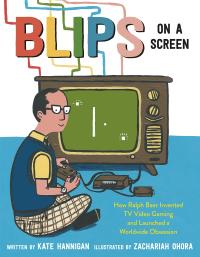
Have you ever wondered about video games, like what came before the Xbox? What inspired the hardworking German immigrant boy who invented them? Readable narration and childlike illustrations tell Ralph Baier’s story. Photographs concludes this playful, inspiring biography.
Blips on a Screen

Many years ago, Eleanor Foraker, better known as Ellie, “helped change the world with a needle and thread.” She and her team worked for a company that made clothing for women and babies. They entered a spacesuit design competition and won. Ellie and team’s A7L spacesuit was worn by Neil Armstrong and Buzz Aldrin to walk on the moon. Actual events inspired this unique look at space exploration.
The Spacesuit: How a Seamstress Helped Put a Man on the Moon
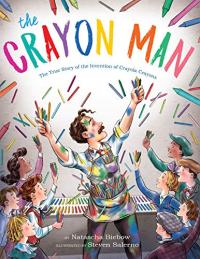
You may not have heard of Edwin Binney but chances are you’ve used his invention: Crayola crayons. Binney’s determination to come up with ways for children to create and draw with non-dusty color led to the invention. His life and legacy (and even how the name Crayola was crafted) makes a memorable story. Illustrated in color and brought right up to contemporary crayon making, this is a fascinating and well documented look at one man’s continuing legacy.
The Crayon Man: The True Story of the Invention of Crayola Crayons

As a kid, Lonnie fiddled around with toy rockets and more. But all of his tinkering led to a career in engineering, working at NASA and inventing the Super Soaker! His life is engagingly presented in text and illustration.
Whoosh! Lonnie Johnson’s Super-Soaking Stream of Inventions

When young Temple was diagnosed with autism, no one expected her to talk, let alone become one of the most powerful voices in modern science. Yet, the determined visual thinker did just that. Her unique mind allowed her to connect with animals in a special way, helping her invent groundbreaking improvements for farms around the globe. Also included are fun facts, a timeline of events, and a note from Temple.
The Girl Who Thought in Pictures: The Story of Dr. Temple Grandin

This fictionalized account of how young Louis Braille lost his eyesight is told through his voice. It is realistic but with lighter touches as well as insight into what inspired him to invent a way for blind people to read. Illustrations augment the information and tone to engage and enlighten readers.
Six Dots: A Story of Young Louis Braille
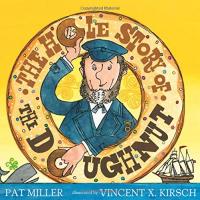
A seafaring cook named Hanson Crockett Gregory is credited with inventing the sweet fried treats we know as doughnuts. Lighthearted, rounded illustrations combine with a humorous narrative to explore the fact and fiction of Hanson and his tasty innovation.
The Hole Story of the Doughnut

Have you ever had an idea spark another notion? A waterwheel may have been one boy’s inspiration for what is ubiquitous at today’s carnivals and amusement parks: the Ferris wheel! George studied engineering and created the world’s first 6-story tall observation wheel which showcased at the 1893 Chicago World’s Fair to the amazement of all. Realistic illustrations and lively text bring the man and his times to life.
The Fantastic Ferris Wheel: The Story of Inventor George Ferris

Richly hued illustrations and an engaging text (that reads aloud well) present a brief look at the life of a girl who was well ahead of the 19th century in which she lived. Ada’s mother left her husband, the philandering poet Lord Byron, moving to London. There she encouraged Ada’s passion for all things math, including developing algorithms for Charles Babbage’s Analytical Engine, an early computer.
Ada Byron Lovelace and the Thinking Machine

Move over Tom Edison! This intriguing look at Tesla’s importance in early use of electricity is well documented and handsomely illustrated first look at an important scientist and inventor.
Electrical Wizard: How Nikola Tesla Lit Up the World

Benjamin Franklin was always curious and thinking outside of the box, even as a boy. Youthful swimming (during a time when swimming was considered unhealthy) led Ben to invent paddles to be more fish-like. One episode from the life of a “smart, stubborn, sensible son of a soap-maker” is presented in humorous, detailed illustrations and lively language.
Ben Franklin’s Big Splash

The story of Louis Braille, the Frenchman who invented the raised-dot alphabet/code now used around the world by blind and visually impaired readers. The text traces Braille’s life from the childhood accident that caused him to lose his sight through his career at the National Institute for Blind Children in Paris. Readers can feel the alphabet and numbers from 1-10 at the back of the book.
A Picture Book of Louis Braille

With a light touch, readers meet Thomas Alva Edison in his world of research and development. It was Edison’s lab that led to things we take for granted today. For example, today we have all kinds of batteries but it all started with Edison’s nickel-iron storage battery. Cartoon illustrations add humor to this lighthearted but informative look at this inventor and his work.
Timeless Thomas: How Thomas Edison Changed Our Lives

The voice of an old, blind Galileo Galilei is used to look back on a life that started in Pisa where early on he challenged tradition. Though confined, the elderly Galileo asserts that, “The truth has a way of escaping into the light.” Bold lines border illustrations to evoke time and place, enhanced by spot illustrations of Galileo’s work and observations.
I, Galileo

The world changed when rags and bone, sticky stuff, and other things came together in the hands of a man who lived in the German city of Mainz. Johannes Gutenberg had printed a book in a new way. Readers will be drawn in as the elements Gutenberg used unfold, illustrated in handsome, realistic illustrations. An epilogue completes this intriguing book.
From the Good Mountain: How Gutenberg Changed the World

Though it’s unlikely that anyone has ever heard of Walter Diemer, chances are they’ve used — or at least heard of — his invention: bubblegum. Diemer’s story from accountant to successful inventor is presented in a lively text with cartoon illustrations.
Pop! The Invention of Bubble Gum
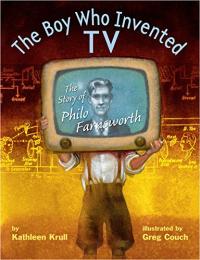
Two machines captivated young Philo Farnsworth: a telephone and a phonograph. Both had cranks and both connected people with others (one in real time, the other through music). These and other inspirations motivated young Philo to invent what was to become known as the television. His early story is fascinatingly told and well illustrated.
The Boy Who Invented TV: The Story of Philo Farnsworth
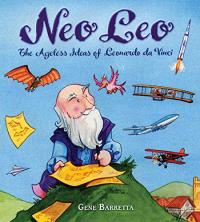
Even though Leonardo da Vinci lived a long time ago (born in 15th century Florence), his ideas have intrigued inventors and scientists ever since. In cartoon-like illustrations and brief text, old “Leo” ideas are juxtaposed to newer “Neo” ideas. This playful book is informative and engaging and may inspire further investigation of man and inventions.
Neo Leo: The Ageless Ideas of Leonardo da Vinci

Ever hear of psychedelic colors? Meet Joe and Bob Switzer who invented interesting new colors — which not only defined a generation but helped save lives. Cartoon-like illustrations complement the tone of this picture book biography.
